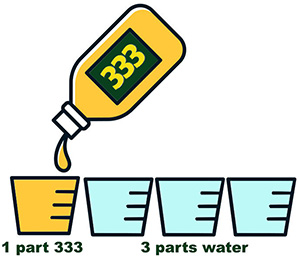
FAQs
-
Why is 333 so popular?
The 333 disinfectant performs so many functions which negates the need to purchase 3 or 4 other products. 333's anti-microbial function is so powerful that consumers have trusted its ability to perform for the whole family, it truly is a "Jack of all Trades" type of product and has over 21 different uses.
-
Does it really work that fast?
Yes it does. Based on consumer feedback over the years, people are amazed at how quickly 333 works. It's no wonder the formula has been trusted for over 80 years.
-
Is the mouthwash the same as the 100ml disinfectant?
The 100ml disinfectant has the same ingredients as the Gargle and Throat spray but sweetened with added mint flavourants to appeal to a broader market that needs a product that works fast, yet has an appealing taste.
-
How do I dilute the 100ml disinfectant?
There are different dilutions for different applications. For example to dilute as a mouth gargle the directions state:
Mix 1 part of 333 to 3 parts of water. What this means is, if you use a small glass, then fill the glass with 333. Using the same glass fill 3 glasses of water and mix. You now have a 3 parts water to 1 part 333.
The same is true if you are using a table spoon. Mix 1 table spoon of 333 and 3 tablespoons of water.

-
I heard it's great for fishing
Yes so have we. For many decades now we have received feedback from freshwater fisherman that bait soaked in the 333 disinfectant has the uncanny ability to attract fish, ensuring a good daily catch. Why this occurs is still unknown.
-
Is the new TCP the same as the old TCP?
No. The current TCP formula has a key ingredient missing, Sodium Salicylate and therefore is not the same as the original South African TCP, nor our 333.
-
What is Sodium Salicylate?
Sodium Salicylate has Analgesic and Antipyretic properties. An analgesic is a painkiller and antipyretic is an anti-inflammatory.
-
Why should I gargle daily?
Gum disease is prevalent in about half the adult population. And lately, more and more research demonstrates just how many different kinds of bacteria grow in our mouths – when last counted over 500 species were found.
Some of the more devastating ones, like P. gingivalis, travel through the blood to other sites and actually attach themselves to our cells, causing inflammation.
And new research presented at the American Association for Cancer Research’s annual conference found a link between certain types of gum bacteria and pancreatic cancer.
The strongest connection: the bacteria P. gingivalis. Study participants who had this type of bug in their gums had a 59% higher risk of getting pancreatic cancer than those without the bug. Pancreatic cancer, as we’ve discussed before, is the deadliest form of cancer. One of the main reasons for its lethal nature is that doctors often don’t catch it until it’s in advanced stages.
While we don’t know exactly how P. gingivalis contributes to cancer, we do know it pries open passages in the gumline, allowing itself and other bugs to enter the bloodstream. Once in your blood, they can travel everywhere, including crossing the blood-brain barrier.
That’s why a study published this spring in the journal PLOS ONE raised concerns. It showed that Alzheimer’s patients with gum disease experienced six times faster mental decline than those with healthy gums.
We’ve also seen evidence that the bacteria T. denticola can find its way to your nerve cells through your jaw. It follows those cells directly up to your brain. While we don’t know if these bugs can directly trigger Alzheimer’s, we know that they cause inflammation… which in turn damages cells and contributes to the disease.
Several studies also highlight the importance of flossing for diabetics. Those with diabetes have a three to fourfold increase in their risk of gum disease. Scientists are still studying the link between diabetes and gum disease and which condition leads to the other, but one thing is clear – the increased inflammation from poor gum health hurts the body.
Many of the worst diseases, like dementia, stem from infection and inflammation. Fighting these two things will go a long way toward preventing serious diseases.
And remember, after flossing, don’t turn to the alcohol-based rinses. Several studies show that the alcohol in mouthwash increases the risk of oral cancers. The proof isn’t absolute, but the link is strong. The alcohol used in the mouthwash breaks down into a known carcinogen, acetaldehyde.
Try a nonalcoholic gargle. Just check the label for alcohol. Many brands advertise that the mouthwash is alcohol-free on the front label.
There’s no reason not to take this precaution to improve your health. Your immune system (and your dentist) will thank you.
